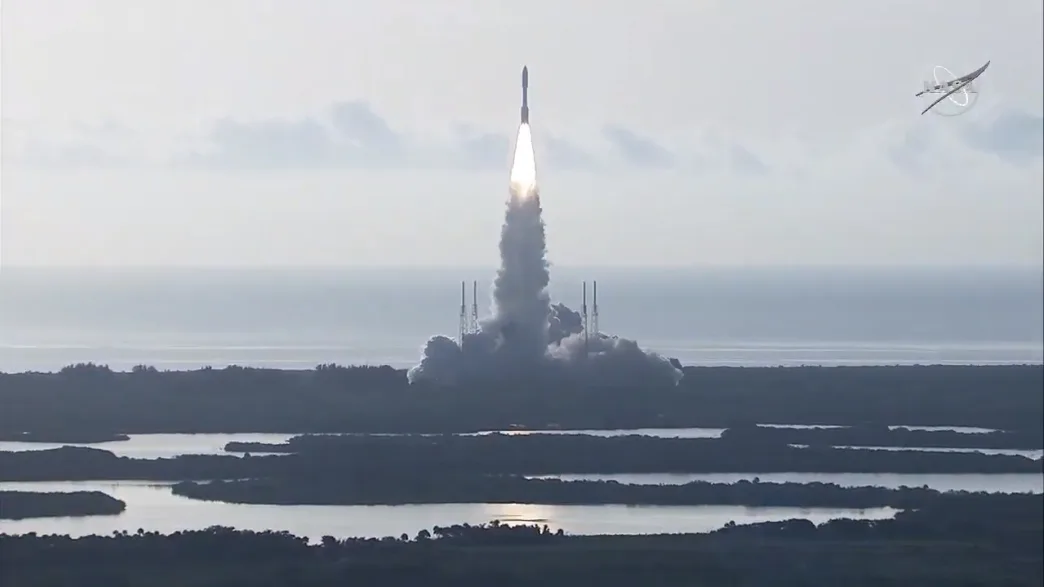
After a flawless launch, NASA's Perseverance rover is off on its journey to Mars
The next phase of Mars exploration is on its way!
NASA's Perseverance rover has started of its journey to the Red Planet, and this mission could make the most important discovery in human history.
This latest mission to Mars lifted off at 7:50 a.m. EDT, on Thursday, July 30, 2020. The launch was broadcast live, via NASA TV, for the entire world to see.
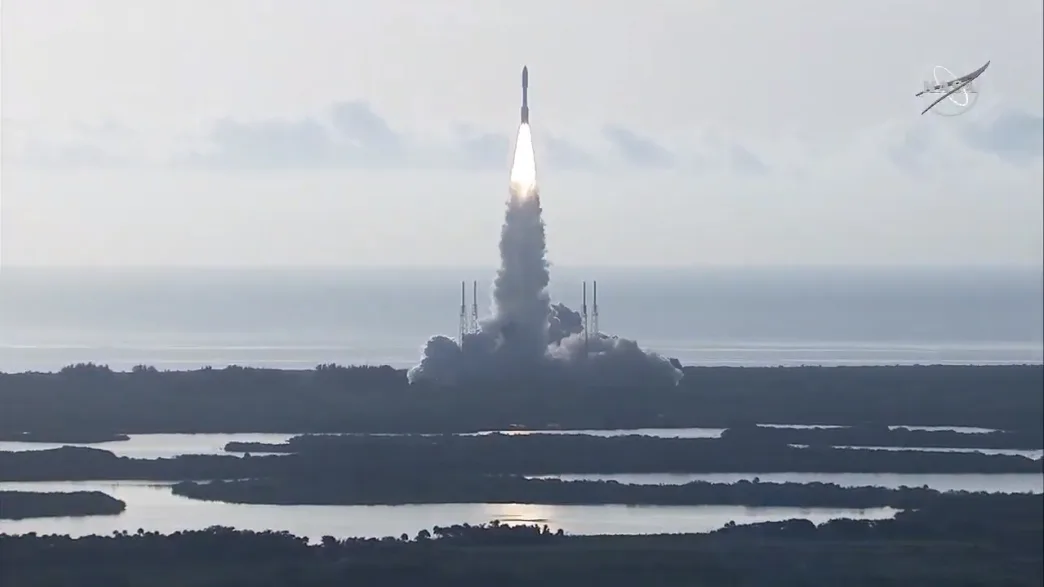
Perseverance launches from Launch Complex 41 on the morning of July 30, 2020, headed to space atop a United Launch Alliance Atlas V rocket. Credit: NASA TV
Weather conditions were perfect for the launch at Cape Canaveral and Kennedy Space Center on Thursday morning, with forecasters noting only a 10 per cent chance of encountering a launch violation.
The only issues the U.S. Space Force 45th Weather Squadron team was watching for were the potential for cumulus clouds or a thick cloud layer near the launch site. Either of those conditions could bring with it the possibility of a lightning strike, which would prevent the launch of the rover.

Several Lightning Launch Commit Criteria (LLCC) are considered for a launch weather forecast. These are all conditions in the vicinity of the launch platform that either indicate the presence of lightning-producing storms or simply conditions that are favourable for the rocket launch to trigger a lightning strike. Credit: U.S. Space Force 45th Weather Squadron
If there had been a delay to the today's launch, due to weather or mechanical issues, backup launch windows were planned for Friday morning and Saturday morning. Any delay beyond Saturday, however, could have likely encountered difficulties due to Tropical Storm Isaias. Based on the storm trajectory between now and Sunday, the entire state of Florida could be impacted by strong winds and rainfall by the end of the weekend.
WHAT IS PERSEVERANCE?
In NASA's continued exploration of the planet Mars, they are now building upon the work of previous missions, especially the Curiosity rover, to take things to the next level.
Perseverance, formerly named Mars 2020, is NASA's next nuclear powered Mars rover.
The Spirit and Opportunity rovers were sent to Mars in 2005 to determine if the environment there was ever favourable for liquid water to exist on the surface. The Mars Phoenix mission was sent in 2008 to support these efforts. After a little over a year of operations for Phoenix, nearly 7 years for Spirit and 15 years for Opportunity, these missions confirmed that Mars was a warmer and wetter planet in its distant past.
Touching down in Mars' Gale Crater in 2012, Curiosity's mission was to search for signs that those warmer, wetter conditions could actually support life. Perseverance, which is based on the same design as Curiosity, has the tools needed to go beyond that. This new mission will actually look for signs that living organisms did, indeed, inhabit those environments, long ago.
WATCH BELOW: PERSEVERANCE - THE SEARCH FOR ANCIENT LIFE ON MARS
If Perseverance is successful in that mission, it will likely be the most profound moment in human history - the discovery that life existed on a planet beyond Earth!
There's an added bonus for this mission, something which has never been done before. NASA is planning to send a helicopter - now named Ingenuity - along with Perseverance, to help with its exploration of Jezero crater. When Ingenuity flies, it will be the very first powered flight performed on another planet!
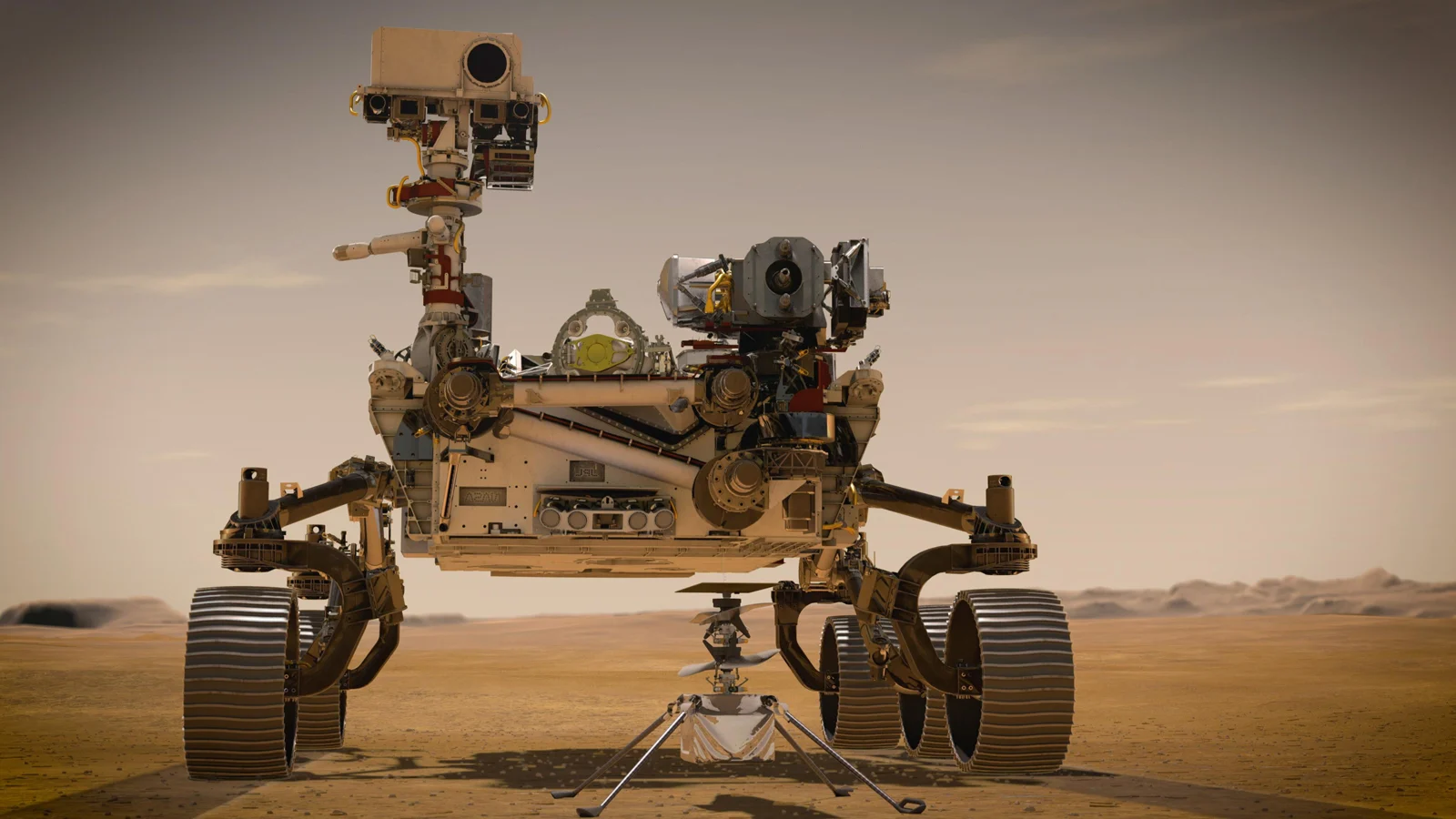
This artist conception drawing shows Mars Perseverance and the Mars helicopter Ingenuity, on the surface of the Red Planet. Credit: NASA/JPL-Caltech
The innovations with this mission don't stop there. Beyond Perseverance's a new suite of science instruments and its remote drone assistant, the engineering team has also upgraded the rover's landing system - the 'sky crane' descent stage.
For Curiosity, the sky crane performed a simple job. After the heatshield and parachutes did their job of slowing the spacecraft down during its descent into the atmosphere, the sky crane flew Curiosity down close to the surface. Once there, it lowered the rover to the surface on a long tether, then disconnected and flew away to crash.
With more potential hazards to deal with on the surface during Perseverance's landing, this rover's descent stage has a new capability, known as Terrain Relative Navigation (TRN). In addition to what Curiosity's sky crane could do, Perseverance's is also be able to steer as it descends, to avoid anything that would damage the rover upon touchdown.
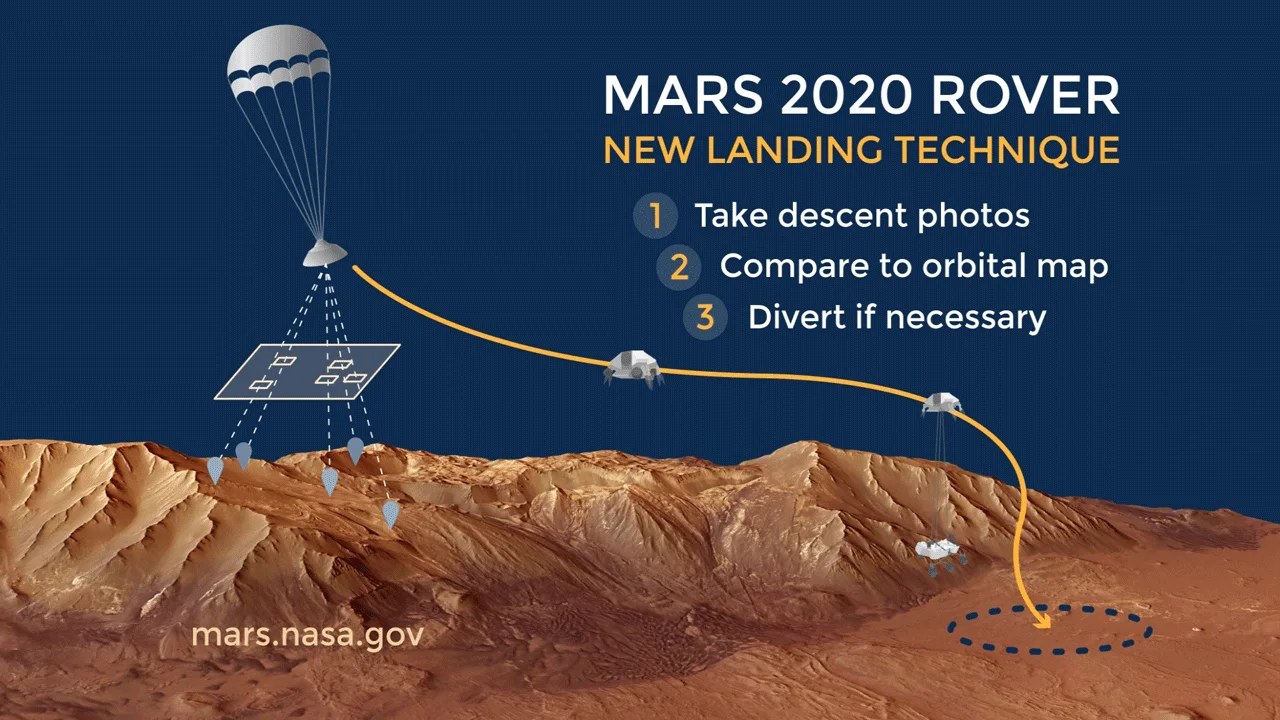
Perseverance's new method of landing, including the Terrain Relative Navigation system. Credit: NASA/JPL-Caltech
Additionally, the Perseverance rover will be the very first to gather materials for future' sample return' missions. Basically, the rover will drill samples from the rocks in Jezero crater and lock them away in canisters. These canisters will then be a target for some future mission, which will retrieve and launch them to Earth. Here, scientists can subject those samples to a range of tests far greater than could be done by any robotic mission we send, and far faster, as well.
Now that Perseverance is on its way, the mission team can breathe a sigh of relief until its landing date in Jezero Crater on February 18, 2021. If for some reason the launch had been delayed until after August 15, NASA would have had to wait until September 2022 for their next opportunity.
WHERE IS PERSEVERANCE GOING AND WHY?
After an exhaustive search and decision-making process, NASA pinned down the landing site of Perseverance to Jezero, a 45-km-wide impact crater in Mars' northern hemisphere. Named after a town in Bosnia-Herzegovina, the word translates to 'lake'.
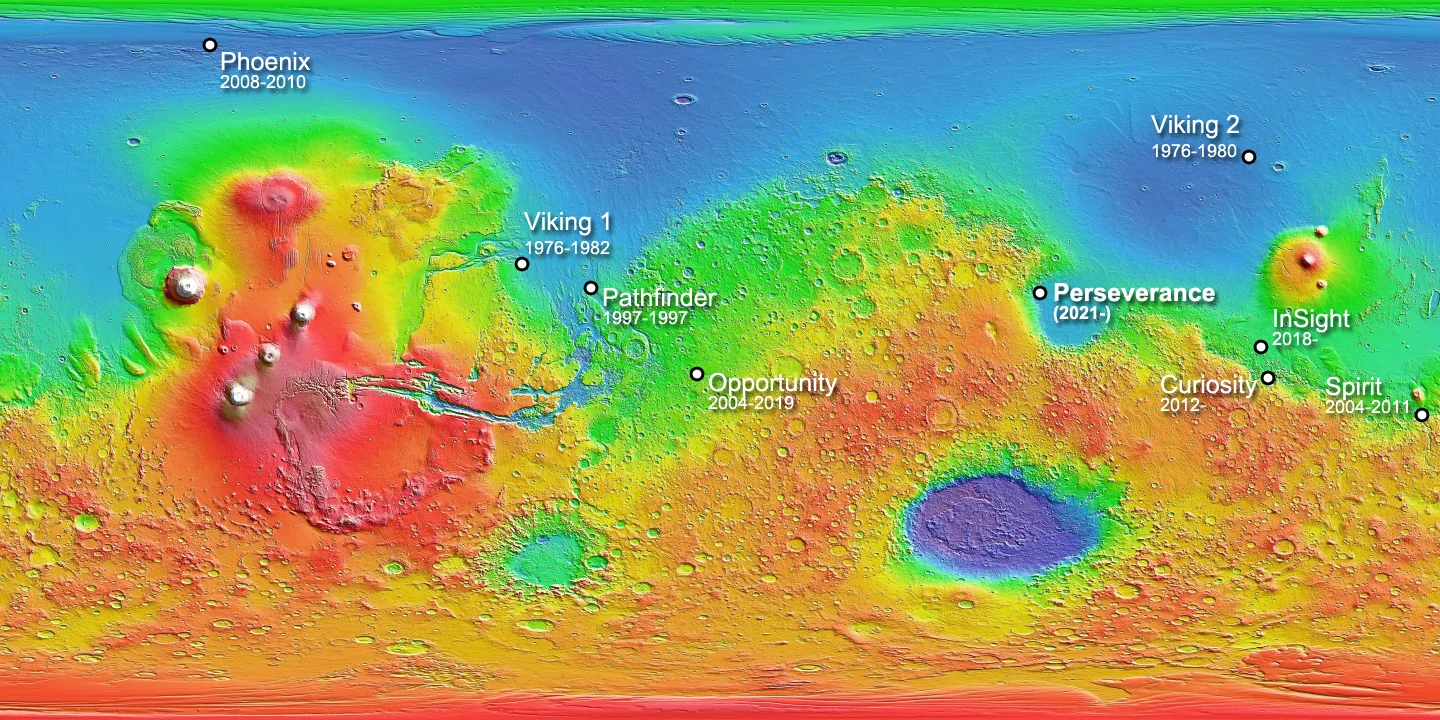
Overlaid on this false-colour Mars topography map are the locations of the various NASA Mars missions and their dates of operation on the surface. Credit: NASA/JPL-Caltech/Scott Sutherland
The name 'Jezero' is very appropriate. According to NASA, the crater was once home to a lake, fed by a wide river delta along its western rim, which "could have collected and preserved ancient organic molecules and other potential signs of microbial life from the water and sediments that flowed into the crater billions of years ago."
"The landing site in Jezero Crater offers geologically rich terrain, with landforms reaching as far back as 3.6 billion years old, that could potentially answer important questions in planetary evolution and astrobiology," Thomas Zurbuchen, associate administrator for NASA's Science Mission Directorate, said in a NASA press release back in November 2018. "Getting samples from this unique area will revolutionize how we think about Mars and its ability to harbour life."

Jezero Crater on Mars has very similar minerology and geology to Turkey's Lake Salda, here on Earth. Credit: NASA Earth Observatory
According to NASA's Earth Observatory: It just so happens that Lake Salda is the only known lake on Earth that contains the carbonates and depositional features (deltas) similar to those found at Jezero Crater. The first image above shows Jezero Crater as observed by MRO’s Context Camera. Spectral data showed signatures of carbonates on the western edge of the crater, which scientists believe to be the shoreline and beaches of an ancient lake. The carbonates are also present in the delta, which is the planned site of the Perseverance landing. The second image shows Lake Salda on June 8, 2020, as observed by the Operational Land Imager (OLI) on Landsat 8. The lake contains alluvial fans full of rock deposits eroded and washed down from the surrounding bedrock (similar to the delta in Jezero). By studying how material is deposited in Lake Salda, the team can learn more about the various depositional processes at Lake Jezero. The white shoreline around Lake Salda is comprised of sands and gravels that are dominated by hydromagnesite, which is similar to the carbonate minerals detected at Jezero. Horgan explained that the hydomagnesite sediments along Lake Salda’s shoreline are thought to have eroded from large mounds called "microbialites" — rocks formed with the help of microbes. In Lake Salda, they formed from microbial mats that lived just beneath the surface of the water near the shoreline. As the microbialities grew, they incorporated carbonate materials and created large terrace islands.
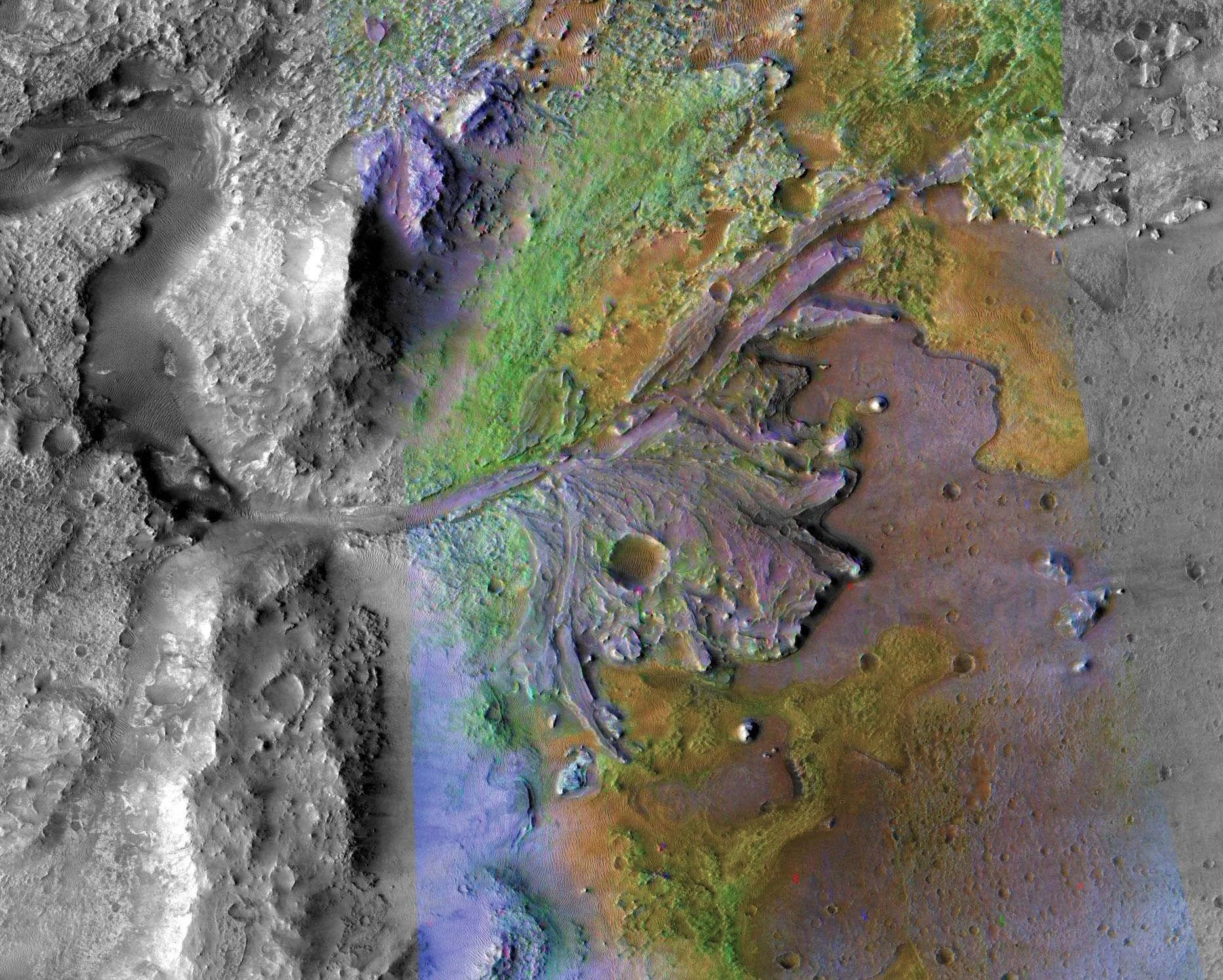
This image shows a false-colour view of the river delta along the western rim of Jezero Crater. The colourful formations on the right side of the image are from a spectral analysis from orbit, revealing the presence of sediments that have been chemically altered by water, such as clays and carbonates. Credit: NASA/JPL/JHUAPL/MSSS/Brown University
Jezero crater was one of over 60 sites considered by the Perseverance team. So, what set it apart from the others, and carried it through to the finale?
NASA went through a few different rounds of deliberations, as it tried to decide where to send this new mission. Even as of February 2017, they still had eight candidates, and through one penultimate round of discussions, managed to narrow it down to just three.
Jezero was one. A nearby region of volcanic, layered features, known as Northeast Syrtis, was another. Columbia Hills, in Gusev Crater (the permanent home of the Mars Spirit rover), on the other side of the planet, was the third.
Columbia Hills was attractive since the Spirit rover had already revealed warm, wet conditions there in the past, where mineral springs flowed up to the surface at one point. Northeast Syrtis' volcanic activity meant that it was once warm and wet. Jezero was known, from the types of formations and sediments detected from orbit, to have been filled with lake water on two different occasions, with a dry period in between.
Both Northeast Syrtis and Jezero had an advantage, though. They were just 50 kilometres apart - relatively close to one another, even with the rover's slow top speed. The team even tried for a compromise, picking a spot midway between the two (which they appropriately named 'Midway').
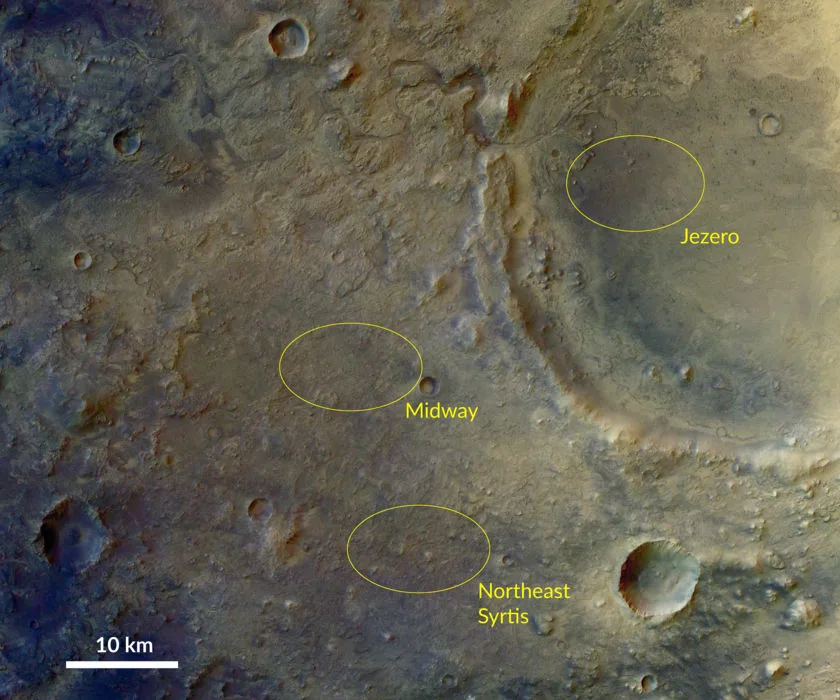
The location of the final three landing sites under consideration for Perseverance, along with the projected landing ellipses. Credit: ESA / DLR / FU Berlin / Emily Lakdawalla
Jezero, however, not only has an abundance of clays and water-affected minerals in its river delta, but there are signs of impact craters in the delta as well. When those impacts occurred is not known. Since meteorites are potential sources of organic molecules, however, impacts could play a part in the development of life. So, this is a very attractive location, indeed.
Plus, with Midway and Northeast Syrtis close enough by, extended missions for Perseverance could have the rover driving up the river that once fed Jezero's lakes (on the left, in the image above), to eventually visit the other two sites, as well.
Sources: NASA | NASA | NASA Earth Observatory | The Planetary Society | With files from The Weather Network











